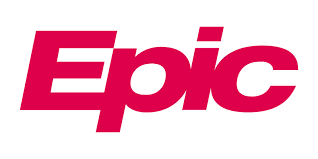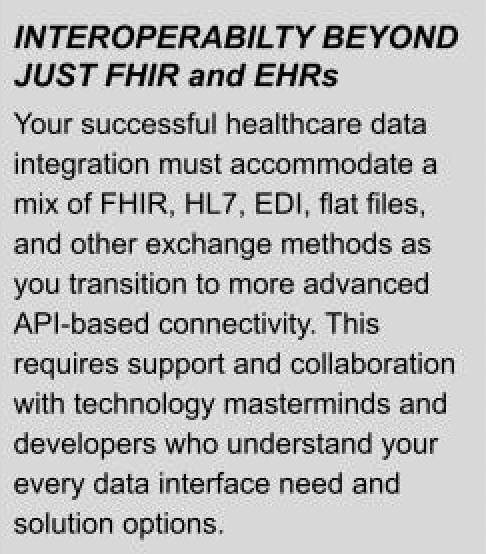See how Epic SMART on FHIR is operating and learn more about its interoperability approach, resources, and API tools
Epic SMART on FHIR and other major EHR vendors have battled, tolerated, and sometimes embraced interoperability for decades.

Today, most EHR vendors have responded to market and regulatory pressure to adopt FHIR API standards and expand patient access to medical records.
But early on, Epic and other emerging EHR vendors scrambled to capture market share and become the dominant onsite, proprietary health records system. Sharing access and data with other healthcare technology vendors seemed self-destructive.
So where does Epic stand today on FHIR APIs, SMART on FHIR, patient access, and interoperability strategies?
Here’s a breakdown and links to important Epic FHIR and interoperability resources.
Epic Strategy and Resources for FHIR APIs and Interoperability

Interoperability Approach and Options
Most Epic integration offerings focus on extending access through Epic systems, but not necessarily sharing with other vendors.
Epic offers several ways to connect:
- Epic participates in and suggests that users CareQuality, a nonprofit “framework to enable exchange between and among” EHRs with standards that providers can adopt quickly to exchange data.
- EpicCare Link lets providers either see or use another provider’s Epic EHRs.
- MyChart and Share Everywhere let authorized patients see and share their Epic records online (it’s patient-focused but only gives access to Epic health records).
In Epic’s words: “Interoperability is key for providers who use Epic to share 100 million records per month—both with each other and with providers using other systems. If your organization uses a different EHR system or none at all, you can still access and exchange patient records with the Epic community in many ways.”

FHIR Interoperability Resources
Epic FHIR API Implementation and Endpoint Resources for Providers:
- Epic on FHIR developer access page with a detailed summary of resources.
- Complete Epic FHIR API specifications, also shared here by interface types
- Epic FHIR app-building page with testing sandbox, signup, and documentation
- To learn more about exchanging information without CareQuality, refer to the Interoperability Guide on open.epic.com.
Epic SMART on FHIR and App Resources
- Epic does not say much at all about SMART on FHIR for developing independent apps connected through FHIR APIs that are not hard-wired to one EHR or data system.
- Epic does support the app development community and promote connected apps in the Epic App Orchard.
Forge Your Epic FHIR API and Integration Success

With a 30 percent market share, the Epic EHR powerhouse is the most significant healthcare technology relationship for many hospitals and physicians. But your interoperability goals sometimes clash with EHR vendor business goals.
Here are steps KMS Healthcare recommends for you to establish confident interoperability and FHIR API technology success with Epic:
- Understand all of your options for Epic interoperability, Epic SMART on FHIR APIs, and integration technologies: Epic does a good job of organizing its technical FHIR resources here. But you should also seek guidance from outside healthcare technology experts with a broader perspective.
- Set your high-level objectives for Epic integration: Do you primarily need to connect with one Epic API endpoint to get patient health record data from a particular health system or physician group? Is there a broader interoperability strategy that requires more points of integration with Epic? Always work your plans backward from the EHR integration success measures you seek.
- Create a data-sharing blueprint: Which of your systems and those of your partners need Epic EHR data integration to deliver the greatest patient access and care? Document the functionality, data models, compatibility, and integration endpoints for your data integration universe.
- Emphasize health data security in every part of your Epic SMART on FHIR integration plans: Set firm data privacy and protection boundaries as you open access to Epic and other health systems with sensitive information.
Even these straightforward Epic integration and FHIR API recommendations take time and energy for your teams already working with limited resources.
Find a FHIR API Advisor and Technology Partner for Epic Systems Interoperability

Successful integration with FHIR API endpoints requires developers and strategists with a rare mix of healthcare, software development, and integration technology brilliance. Here’s how KMS Healthcare interface technology experts will help steer your Epic interoperability success:

- Assess and outline your Epic data exchange challenges and opportunities.
- Help you understand Epic interface tools, technologies, advantages, and limitations.
- Define your strategic interoperability roadmap, whether it’s connecting to one FHIR API or connecting numerous healthcare data systems.
- Establish a confident, secure technology and process path forward Epic integration and FHIR APIs that will deliver data harmony.
- Do the highest quality Epic integration technology work on a fast, reliable schedule.
Our expert development, testing, QA, and documentation will advance your Epic integration objectives beyond your expectations.
Demand this level of knowledgeable guidance and healthcare technology mastery from any partner you consider.
Accelerate Your Integration with Epic, FHIR, and Beyond

A powerful technology tool can accelerate your connection with Epic FHIR API endpoints.
KMS Connect provides a ready, smart plug-in platform that does most of the heavy lifting for building FHIR interfaces for you and your customers. This FHIR “engine” immediately delivers 80 percent or more of the FHIR infrastructure you need for every API you develop. Start FHIR API projects with the finish line in sight.
But it gets so much better:
- It’s more than just FHIR integration. Plugin prebuilt connectors to other EHRs and health data systems.
- It’s bigger than just FHIR. Swiftly enable data sharing via HL7v2, EDI, and flat files—every way that healthcare continues to exchange data for real-world interoperability needs.
Realize substantial benefits:
- Build Healthcare Data Interfaces Faster and Easier: Start your interface development with prebuilt FHIR, HL7, EDI, and other connectors to get the job done right and fast.
- Save Money: By cutting out 80 percent of the effort to build FHIR APIs and other interfaces your developers can focus on other priority projects and amplify technology returns.
- Build Better FHIR APIs: Standard tools, protocols, testing, and development discipline make FHIR APIs more effective, reliable, and consistent. The standard also introduces concepts such as “resources” that make data mapping more intuitive and APIs more effective.
- Accelerate Returns from M&A and Other Vendor Partners: Rationalizing and integrating new platforms can take years. Plug in an integration accelerator to make systems work together quickly and effectively while planning and executing future integration plans.
- Be ready for SMART on FHIR: Let developers and providers create apps that connect to open EHR FHIR APIs, connecting patients with health records and doctors with live care guidance.
What Next?
Consider KMS Healthcare as your expert guide to establish winning interoperability strategies and deliver exceptional technology solutions for Epic, FHIR, EDI, HL7v2, and every healthcare data system and interface option.

Click to start your path to data integration harmony and simplified development processes with KMS Healthcare…